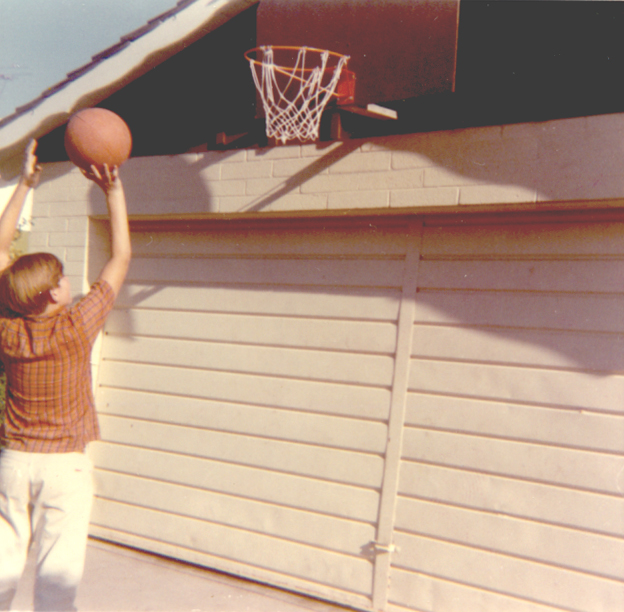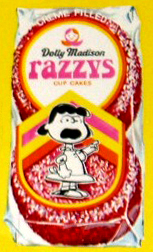|
Page A3 The Joan De Arc Crusader / Monday, December 31, 2007 Front Page A1 / Editorials A2 / Crossword A4
A brief history of hoops on Joan De Arc
By J. Bueker Once upon a time, in an obscure past that seems ever more remote, kids used to pursue genuine physical activity as a recreational outlet. No, seriously. There was no Internet, no video games, no cell phones, no texting, no DVDs, no hi-def TV with 300 channels full of insipid “reality” shows. On Joan De Arc in the ‘60s and ‘70s, we actually had to go outside and make our own fun; and yet it was never any more distant than our very own driveways. The driveway at 3219 was the scene of many remarkable activities, games and sporting events during the Bueker years, some of which have no doubt passed beyond the reach of living memory. There were the early “four square” competitions, the street hockey tournaments, wiffle ball games, and tennis matches. The Bueker driveway even served as deep left centerfield for our street softball games on the side yards adjacent to the Dickey’s and Wells’ properties. But needless to aver, the most enduring and fabled 3219 driveway competitions were doubtlessly those of the basketball variety. Roundball was a popular pastime in Surrey Heights even before the advent of the Joan De Arc era, inspired in large measure by the successful school teams and rough but accessible asphalt courts gracing the playground at Sahuaro School. But with the awarding of the Phoenix Suns’ NBA franchise in 1968, the neighborhood basketball culture was fundamentally and forever altered. A certain legitimacy was now conferred upon the pastime, and the number of driveway basketball hoops in the neighborhood began rapidly to rise. By the late ‘60s, the Bueker boys were growing rather tall and displaying an emerging interest in various athletic competitions. Carl Bueker at length concluded that a basketball rim and backboard were sorely needed at 3219, especially since he had a pronounced fondness for the game himself. However, an obstacle to the plan quickly presented itself: Barbara Bueker was shocked and appalled at the very idea of defacing the front of her lovely home with an ugly and gratuitous basketball apparatus. Father worked out a compromise of sorts, although extensive doubt remains that it ever succeeded much in soothing Mother’s concerns in the matter. The decision was finally reached (by Carl naturally) to install a semi-circular wooden backboard on the house above the driveway and paint it the identical shade of dark brown as the existing trim of the house upon which it was mounted. The reasoning of course was that a backboard so camouflaged would smoothly blend in with its surroundings and escape all but the closest scrutiny of passersby (and potentially aghast neighbors). The effectiveness of this adept strategy of concealment was naturally mitigated somewhat by the bright orange of the basketball rim and glimmering white of the attached cotton net. Ever so true to form, Father Carl sought the most cost-effective means possible for producing the new basketball court at 3219, utilizing some random materials already at hand. He cut and combined two layers of leftover quarter- inch plywood to form the backboard, and then cleverly adapted an old scrap of aluminum c-channel that had somehow found its way into our garage as the structure that would support the backboard and affix it to the house. Never before or after was there a more exquisite example of my father’s stinginess being so perfectly matched by his resourcefulness. Unfortunately, the resulting backboard proved a bit too flimsy to provide an adequate banking force for something as substantial as a basketball and it knew it, fluttering violently with each bank shot that came its way. Another problem with the new Bueker ball court was the garage door situated immediately beneath the basket. Many an errant field goal attempt would crash immediately into the door, announcing every pitiful air ball as far away as Ricky Rose’s house with a characteristic BOOM. Soon a distinctive stippled pattern of dings and dents began appearing on the metallic door, some of which may still be discerned to this day. I don’t believe Mother was very pleased with this phenomenon either. Despite the new ball court’s lamentable shortcomings, it was excitedly embraced by the Bueker boys and put into immediate use. No longer would we be obliged to trudge down to the Sahuaro playground or open gym at Moon Valley High to shoot a few hoops. One of the first actions I personally took was to carefully measure off fifteen feet from the rim and mark the resulting spot with a long strip of masking tape. This of course became the free throw line, which was still visible years after the actual tape had long since worn away. The ability to make foul shots is an indispensable basketball skill, both in actual competition and in “21,” a classic and popular game on the 3219 court. The 3219 driveway basketball court certainly saw an interesting parade of varied activities as the years passed. The Bueker men for instance breathed new life into the traditional shoot around game of “Horse” by rechristening it “Razzy,” in honor of an artificially flavored raspberry Dolly Madison snack cake popular at the time. Inspired by the successful Community Football League (CFL) of the 1960s, neighborhood kids formed a new basketball league named, naturally, the CBA. Though lasting only a season or two, the CBA provided some very dramatic athletic competitions on the street, usually played out on either the Bueker or Harris driveways. In the early ‘70s, Carl rigged an outdoor lighting device that allowed us to play night games at 3219, adding an entirely new dimension to the competition. You know, it doesn’t get much cooler than that.
Neighbors like Tim
Smith and Jack Humphries made memorable forays onto the Bueker driveway ball
court. Mr. Humphries had a very unusual “leg kick” set shot technique that was
usually deadly accurate, and he often triumphed in the open Razzy tournaments.
Tim was also a very skilled shot, and as far as I know he still holds the Joan
De Arc record for the most consecutive free throws made without a miss. I can’t
recall now what that exact record was (somewhere in the neighborhood of 30), but
I do remember his frequent boasting about the achievement for years afterwards.
We were also joined on the court in 1971 by my sister Sue’s fiancé Doug Maselli,
The basketball court
at 3219 served as an invaluable resource for practicing and honing the skills of
the craft, culminating in the zenith of my roundball career as an 8th grader at
Sahuaro. Paul Lee was a 5th grade teacher at Sahuaro, joining the faculty in 1969. He was an extremely kind and polite Asian-American gentleman who had done a pretty good job of coaching my 6th grade flag football team a couple of years earlier. Unfortunately, Mr. Lee did not appear to know a great deal about the game of basketball, and it showed. On the other hand he was intelligent, enthusiastic, and determined. Plus, he was apparently the only faculty member who came forward to volunteer for the job. Heading into the new season, and our final year at Sahuaro, my classmates and I knew we had the makings of a solid ball club. In addition to yours truly at center, the starting line-up would feature guards Bobby Gess and Jeff Britts, along with forwards Don Mollihan and Jeff Meintel, gifted athletes all. The starting five was bolstered by a number of high quality sixth men like forward Lynn Pagan, who would go on to a storied career at Payson High School, and guard Ricky Drost, who wielded a lethal outside set shot. In November of 1971, as the new Sahuaro basketball school team assembled and began practices, a promising omen of things to come presented itself. Wayne Mauer, a popular junior high math teacher at Sahuaro, suddenly joined the coaching staff, providing Coach Lee and his team with a much needed focus and sense of direction. Mr. Mauer’s can-do attitude and detailed understanding of the game energized the Sabers, leading us to an outstanding 32-7 season, including the coveted Washington Elementary School District championship, the first in school history. Mr. Lee’s spirit and organizational contribution to the effort should not be overlooked, but there is little doubt that Mr. Mauer’s presence that year transformed a good team into a championship team. Sadly, Paul Lee passed away suddenly and unexpectedly just months later. As it turned out, that triumphal ‘71-’72 season would be the high water mark of my basketball career. I endured a series of knee surgeries in the years following 8th grade, and when I finally made it back to the starting line-up on the varsity squad my senior year at Moon Valley, we managed to lose every single game. Yep, every last one. We even regularly lost to the junior varsity squad in our inter-squad practices. My b-ball wheel of fortune had forever turned a full one-eighty. Yet that crowning disaster of my competitive basketball years in no way detracts from the sweet victories of the ’72 Sahuaro team, nor from the countless hours of fun shooting hoops over the years on the Bueker driveway. On the contrary, 0 and 21 made me realize how very lucky we had been all along. Thanks Dad, for putting that wonderfully flimsy backboard up on the house at 3219. I think even Mother forgives you now. _______________________________________________________________________________________________________________________JDA
|

